You've likely heard the advice that increasing your fibre intake is beneficial, yet many of us fall short of meeting this nutritional goal.
Incorporating a diverse array of plant-based foods into your diet can significantly enhance your fibre intake and unlock a host of health benefits. But with so many options available, navigating this terrain can feel daunting. Fear not! This blog post is your comprehensive guide to all things fibre, addressing your questions and empowering you to embark on a journey toward a healthier, fibre-rich lifestyle.
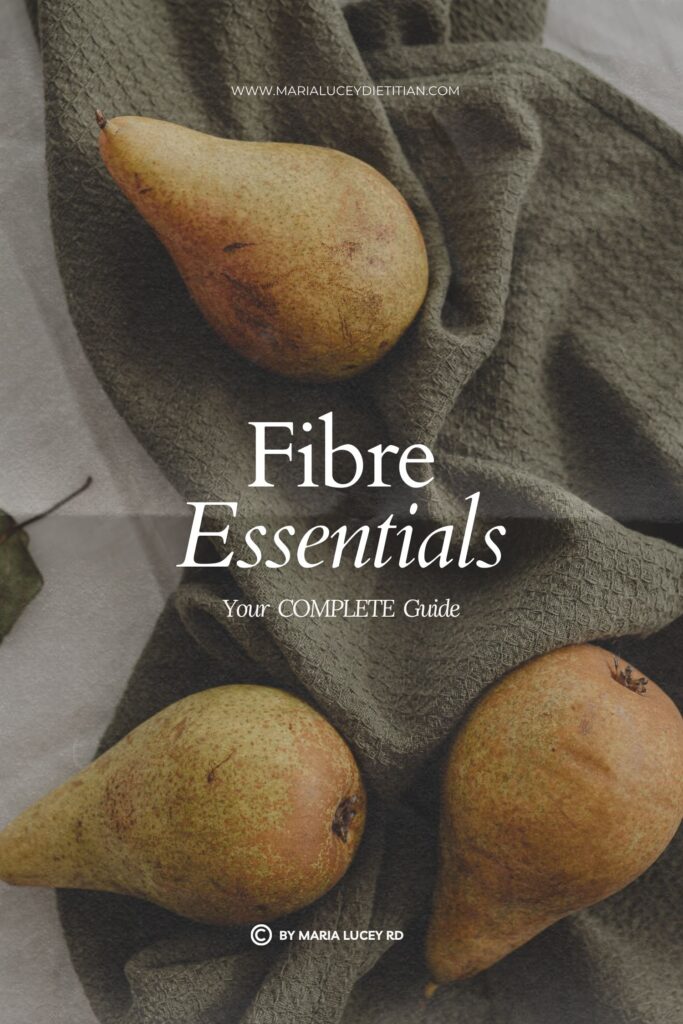
🌟 Download Your FREE Complete Guide to Fiber! 🌟
Looking to boost your dietary fibre intake? Click the link above to get your hands on the comprehensive eBook, which is absolutely free! Make the most out of your nutrition today. 🍏🥦
This post is all about fibre and the top fibre foods.
What Is Fibre?
Fibre is a type of carbohydrate and comes from plants. Unlike other carbohydrates (sugar and starch), it is not digested and absorbed in the small intestines. Instead, it passes undigested into the large bowel, where it’s completely or partially broken down by the bacteria that naturally live there.
What Are The Different Types Of Fibre?
There are over 100 types of fibre, but to keep it simple, we generally divide them into two groups: soluble and insoluble fibre.
Soluble fibre is a “softer fibre”, and it absorbs water in the gut. It’s found in:
- oats
- barley
- pulses (such as beans, peas and lentils)
- and some fruits and vegetables
Insoluble fibres are the “roughage” found in plant foods that our body can’t break down. They add bulk to your stool. They are found in:
- wholegrains, especially the bran part of the grain
- vegetables
- And the seeds and skin of fruits and nuts.
How much fibre does an adult need?
Generally speaking, we need to eat about 25 grams per day (as per European Food Safety Authority recommendations). To be more specific, we need to eat 14 grams of fibre for every 1000 calories we consume each day. So, lots of people need more than 25 grams. For example, we need 35 grams per day if we need to fuel our body with 2500 calories worth of food in a day.
How much fibre does a child need?
In Ireland, the recommended amount for children is their age, plus 5g of fibre per day. So, a five-year-old child should be getting 10 g a day (5 years + 5g of fibre).
However, the new WHO guidelines suggest significantly higher fibre intakes for children, starting at 15 grams of fibre per day for children aged two years and older.
Are We Eating Enough Fibre?
In Ireland, about 80% of people are fibre deficient, and fewer than 1 in 10 American adults meet their daily fibre recommendations, according to the American Society for Nutrition.
Health Benefits Of Fibre
Heart Health
Fibre can help lower cholesterol and improve blood pressure. This results in a reduced risk of heart disease.
Weight Management
Research suggests that fibre can play a major role in body weight. People who eat more fibre are slimmer than those who don’t. Fibre expands and bulks food in your GI tract, slowing digestion. This can increase your level of satisfaction and stabilize your blood sugar. Foods high in fibre also tend to be lower in energy density, meaning they’ll help you feel fuller without excessive calories.
Digestion
Fibre helps keep everything moving. One benefit of sufficient fibre in your diet is a reduced risk of diverticulitis, a condition in which pouches in the colon become infected.
Gut Bacteria
A diet high in fibre supports a diverse gut microbiome. This has been linked to improved physical and mental health.
May Increase Your Life Span
Studies note that people who eat a higher intake of fibre tend to have lower rates of heart disease, metabolic disease, mood disorders, and risk of colorectal cancer. Ultimately, they then live longer!
How To Reach Your Daily Fibre Target
I don’t believe you need to log your food in an app or meticulously count out every gram of fibre you consume in a day. Instead, try to abide by these 4 principles:
- Aim to have a minimum of 5 portions of fruit and veg daily, ideally more.
- Choose wholegrain bread, pasta, rice, etc., by default most of the time.
- Have nuts and seeds at 1-2 meals or snacks daily.
- Use beans, legumes and pulses frequently. Dinner 2-3 times a week.
Simple Tips For Increasing Your Fibre Intake
Incorporate some of these tips to make meeting your fibre intake even easier.
- Choose a high-fibre breakfast cereal. This is a great way to start your day.
- When eating potatoes or sweet potatoes, leave the skin on.
- Have an oat-based cereal bar as a snack (*be aware of sugar content - check the label).
- A handful of nuts or trail mix is a great snack.
- Mix linseeds into yoghurt.
- Add nuts & seeds to salads.
- Leave the skin on fruits where possible.
- Keep a supply of frozen fruit and vegetables so you are never without them.
- Sprinkle oat bran on cereal.
- Add pulses such as beans and lentils to stews, curries, stir-fries, etc.
TOP TIP: Increase your fibre intake gradually to avoid gastrointestinal symptoms such as bloating and gas and allow your gut to adjust to the higher intake. Drink plenty of fluid to let the fibre do its job correctly, aiming for 8-10 cups per day at regular intervals.
I have put together some fibre cheat sheets below to help make your life easier!
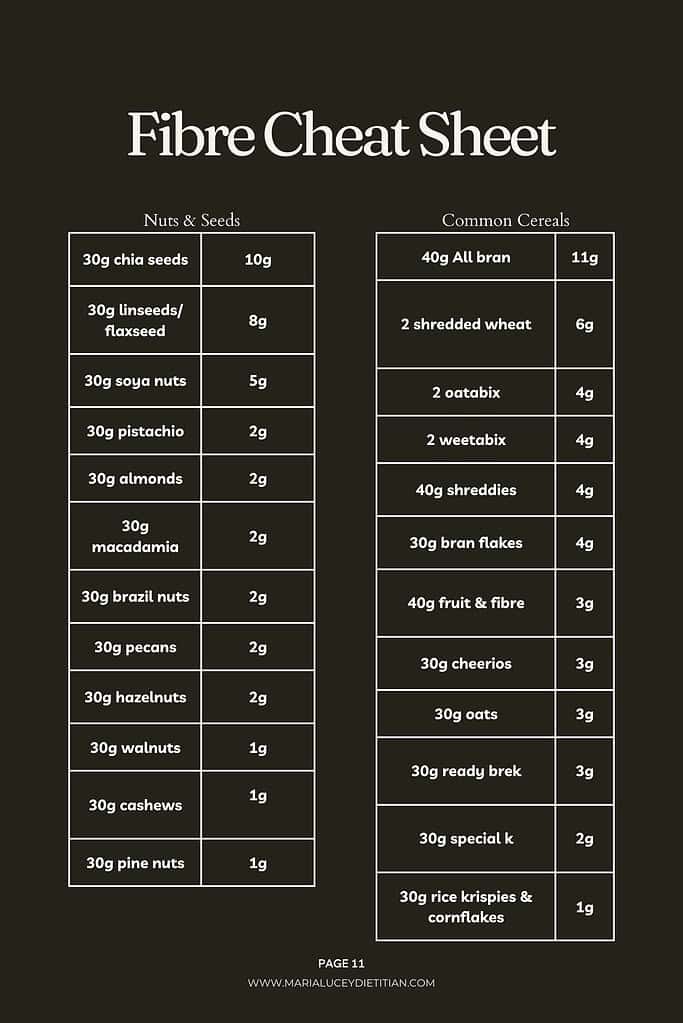
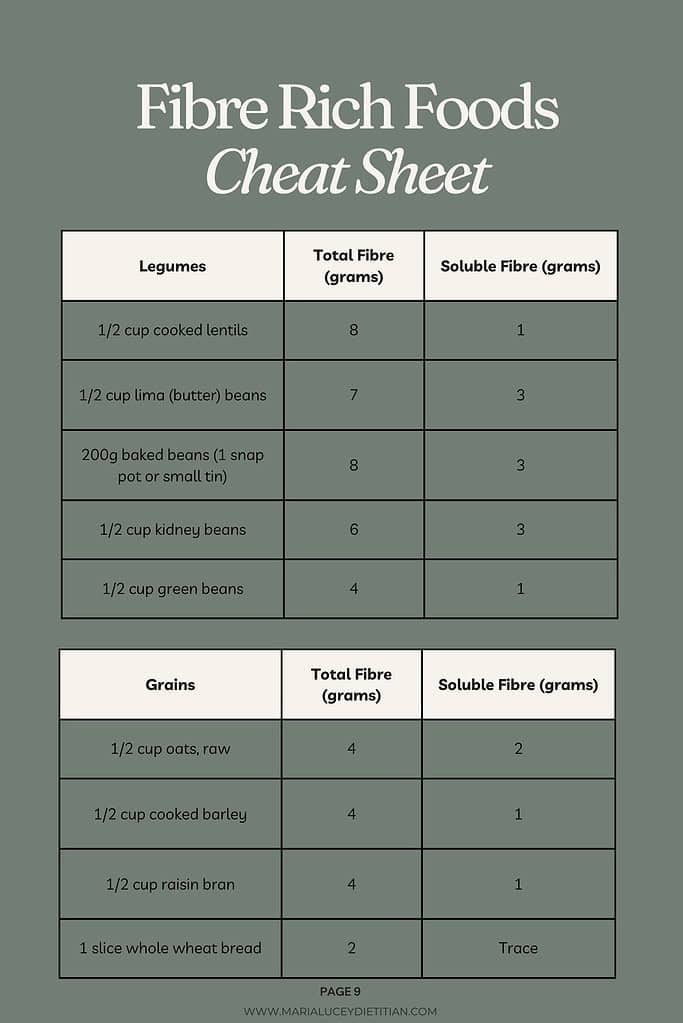
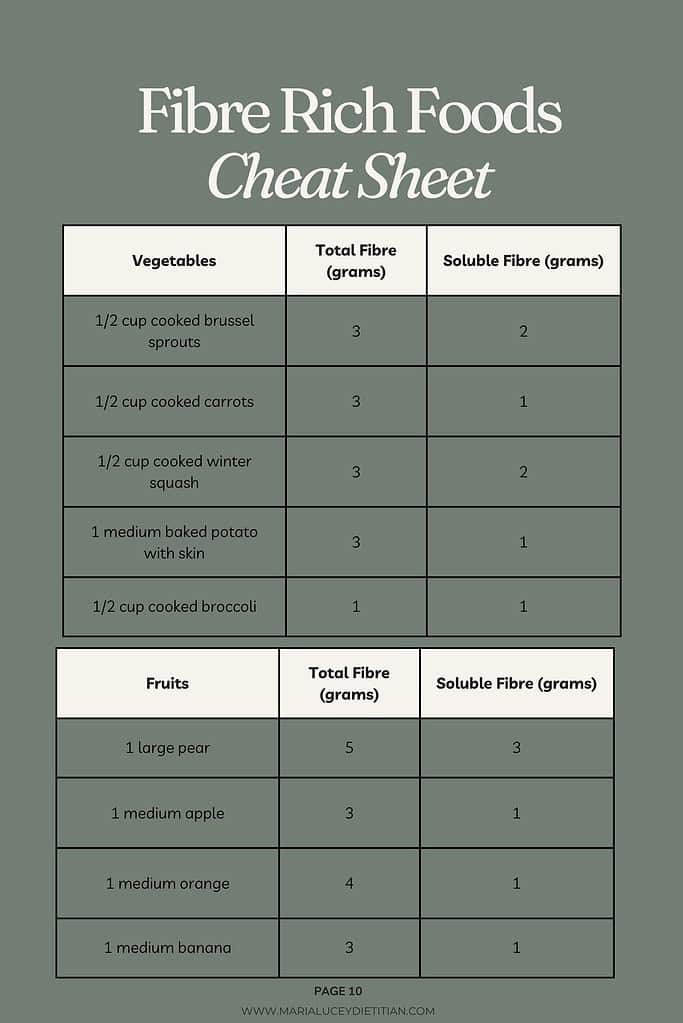
High Fibre Meal Plan Examples
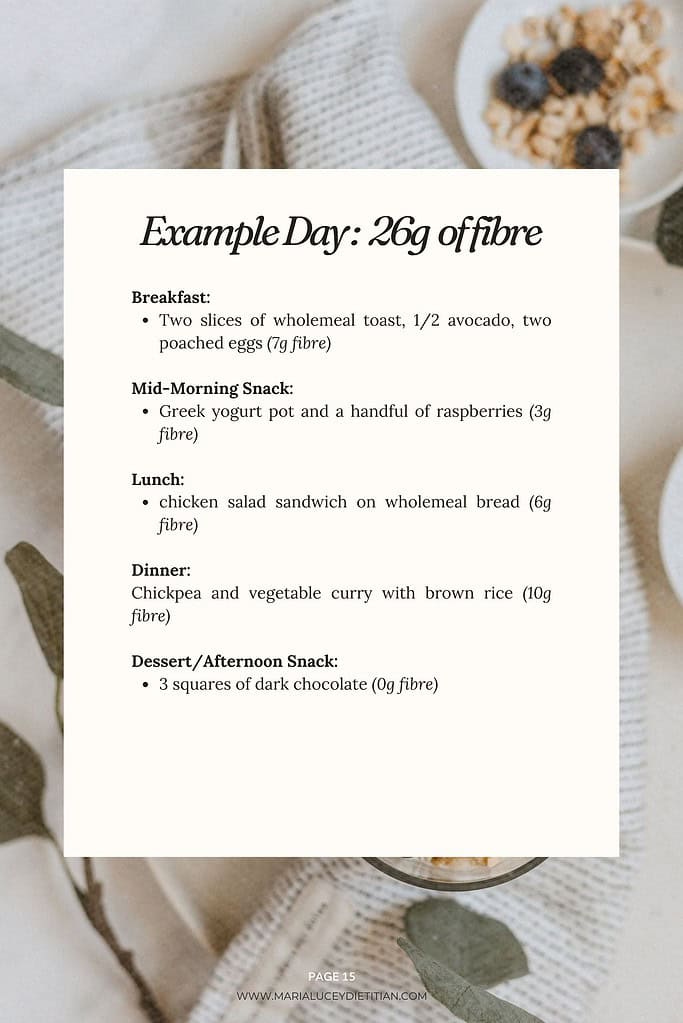
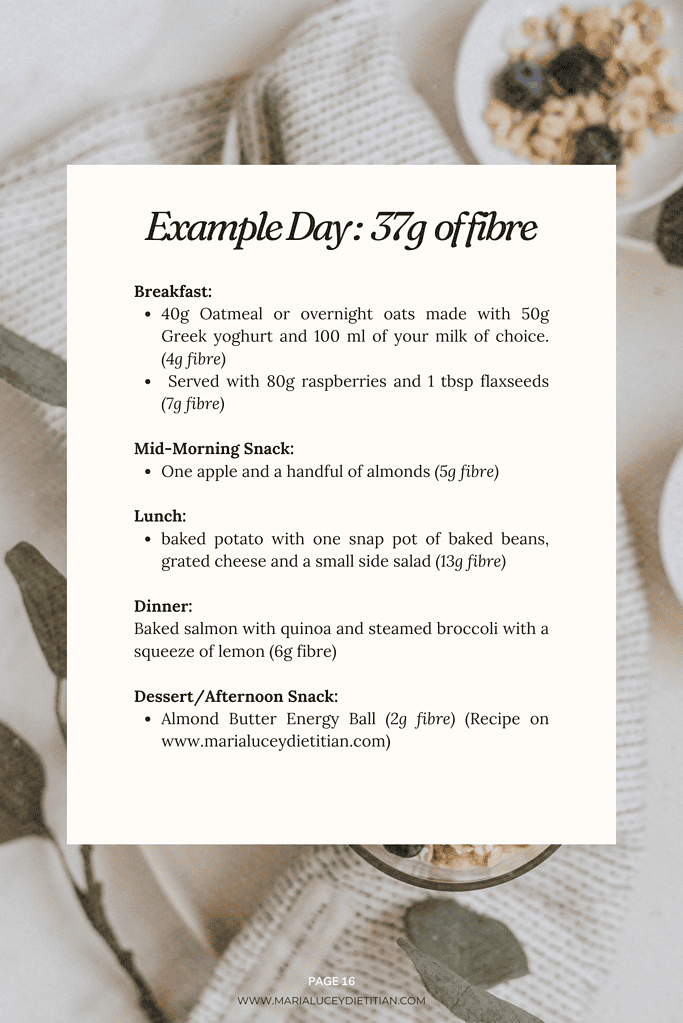
A Word On Beta-Glucans
Beta-glucan is a type of soluble fibre found naturally in a variety of food sources, such as oats, barley, and rye. It’s associated with numerous health benefits, including lower cholesterol levels and improved immune health.
We know that 3g of beta-glucan a day helps actively lower cholesterol.
You can get this by eating three servings of the following foods:
- A small bowl of porridge (using 30g of porridge oats)
- 13g (1-2 tablespoons) of oat bran – sprinkled onto cereals or added to casseroles, soups or smoothies
- 250ml of an oat drink (containing at least 1g of beta-glucan per serving)
- One oat breakfast biscuit
- One serving of oat breakfast cereal flakes (30-35g)
- Three oatcakes
- Recipes providing at least 30g of oats per serving
- 75g cooked pearl barley – add this to stews, casseroles, salads or use instead of rice to make a risotto
- 40g of barley flakes
Connect with Maria Lucey, RD!
I hope you found this article helpful; if you have any questions, please comment below or reach out to me on social media.
I hope you love this recipe as much as I do. If you try it, let me know what you think by leaving a rating and a review in the comments below. Oh, and be sure to take a photo and tag me on @marialuceyrd_dietitian so I can see!
Don’t forget to follow me on Instagram, YouTube, and Pinterest so you never miss a new recipe or blog post.
Other Recipes You May Also Enjoy:
- 💫The Original Baileys Cheesecake Recipe – Irish Cream No-Bake Cheesecake
- 💫Almond Butter Energy Balls Recipe
- 💫 Crispy Cauliflower Wings with Homemade Healthy Ranch
More about the author:
Hi there! My name is Maria, and I am a Registered Dietitian practising in Ireland and Bermuda. I have extensive experience in helping clients improve their health through the power of good nutrition. I hope you enjoyed this recipe. If you have any questions or concerns, please do not hesitate to contact me. Additionally, if there are nutrition topics or recipes you would like me to make in future posts, please let me know. I would be more than happy to help.
Stay happy and healthy 💚
Your Registered Dietitian
Maria xoxo
Check me out on YouTube!
🎥 Visit my YouTube Channel to learn more about my approach to eating and see many of my healthy recipes.





Leave a Reply